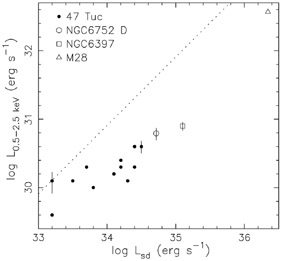


4.2. Millisecond pulsars
Most identifications of X-ray sources in globular clusters with recycled radio pulsars are based on positional coincidence. The exceptions are the identifications of the pulsar in NGC6626 (M28), which is based on the pulse period, and of pulsars in NGC6397 (XB) and in 47Tuc (W29/PSRW) which are based on their orbital periods.
The pulsar in M28 was the only pulsar in a globular cluster identified with an X-ray source before the Chandra observations. By comparing the on-pulse X-rays with the off-pulse X-rays, the X-ray spectrum of the pulse could be isolated (Saito et al. 1997). Chandra resolves the pulsar from other cluster sources and obtains a phase-averaged power law spectrum with photon index 1.2 (Becker et al. 2003).
Because accurate (timing) positions are not yet available for many of the radio pulsars, it is likely that some of them have been detected in X rays already but not yet identified as such. In fact, an X-ray source in NGC6397 was first identified with a possible BY Dra binary (Grindlay et al. 2001b); it was then found that this binary houses a radio pulsar (Ferraro et al. 2001). Similarly, NGC6752 CX11 was identified by Pooley et al. (2002a) with a possible cataclysmic variable or background galaxy, but now is more probably identified with PSRD in that cluster on the basis of newly determined timing positions (D'Amico et al. 2002); positions of X-ray sources are coincident with the timing positions of PSRs C and (marginally) B.
Verbunt et al. (1996)
showed that for the radio pulsars detected in
X-rays with ROSAT, L0.1-2.4keV
 10-3
Lsd, where
Lsd
10-3
Lsd, where
Lsd  I
I 
 is the loss
of rotation energy, usually referred to as the spin-down luminosity, with
I the moment of inertia and
is the loss
of rotation energy, usually referred to as the spin-down luminosity, with
I the moment of inertia and

 2
2 / P.
In accordance with this scaling, the radio pulsars detected in
X-rays so far are those with the highest Lsd of those in
the clusters observed with Chandra.
Grindlay et
al. (2002)
assume that the electron density in 47Tuc
is homogeneous, and from small differences in dispersion measures
determine the position of each pulsar along the line of sight;
this is then used to correct the observed period derivative for
gravitational acceleration in the cluster potential. Comparison
of the corrected spindown luminosities with the X-ray luminosities led
Grindlay et
al. (2002)
to suggest that
Lx
/ P.
In accordance with this scaling, the radio pulsars detected in
X-rays so far are those with the highest Lsd of those in
the clusters observed with Chandra.
Grindlay et
al. (2002)
assume that the electron density in 47Tuc
is homogeneous, and from small differences in dispersion measures
determine the position of each pulsar along the line of sight;
this is then used to correct the observed period derivative for
gravitational acceleration in the cluster potential. Comparison
of the corrected spindown luminosities with the X-ray luminosities led
Grindlay et
al. (2002)
to suggest that
Lx  (Lsd)1/2.
They further note that the pulsar in NGC6397 agrees
with this (slower) trend, whereas the pulsar in M28 does not.
(Lsd)1/2.
They further note that the pulsar in NGC6397 agrees
with this (slower) trend, whereas the pulsar in M28 does not.
We reinvestigated the relation between X-ray and the spindown luminosities for the globular cluster pulsars in Figure 10. We include NGC6752D, and the pulsar in M28. It should be noted that the luminosity of the pulsar in M28 is only about 20% of the total cluster luminosity as observed with ROSAT (Verbunt 2001; Becker et al. 2003), whereas the value used by Grindlay et al. (2002) is the total cluster luminosity. We see no reason to exclude the pulsar in M28, and are inclined to conclude that the general slope of the relation between Lx and Lsd is similar to that observed for the pulsars detected in the Galactic disk, with some scatter at the lowest luminosities.
 |
Figure 10. X-ray luminosities as a function
of spindown luminosities, Lsd, of radio pulsars in
globular clusters. The unresolved pulsar pairs G/I and F/S in 47Tuc
have been omitted. The dotted line indicates
L0.1-2.4 keV = 10-3 Lsd
(Verbunt et
al. 1996),
with a small correction for the different X-ray energy range.
The cluster pulsars lie below, but roughly parallel to this relation.
Notice M28 in the upper right hand corner.
Several 1 |